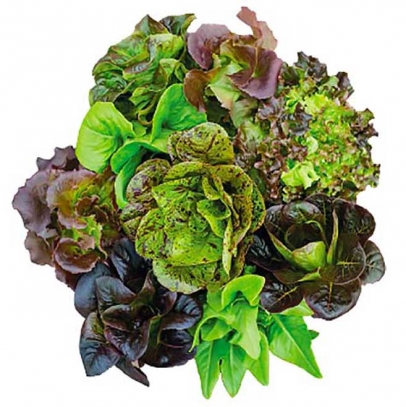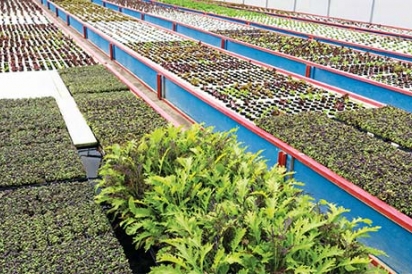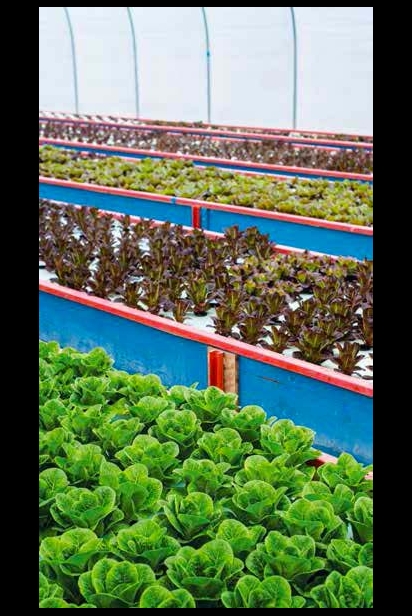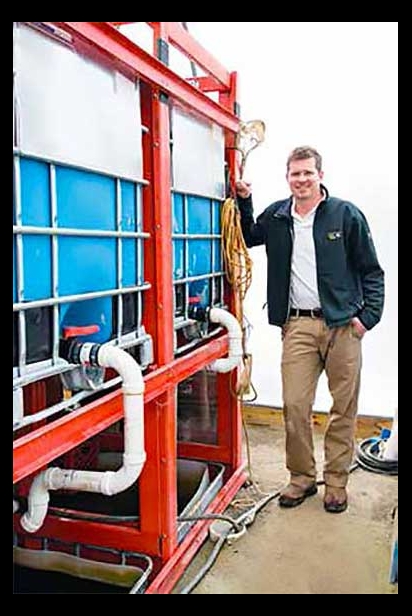A Fish-ious Circle
Closed-system aquaponics, restaurant demand help Groganica Farms thrive
Anyone who’s cleaned an aquarium knows even small fish can be disgustingly dirty.
But Mac and Amanda DeHart have a different view on fish waste: It’s both powerful plant food and the revenue-producing fuel for their burgeoning aquaponic greens business, Groganica Farms.
Inside the couple’s 3,000-square-foot greenhouse, located just outside Louisville, they are rearing tanks holding hundreds of two-inch-long koi, whose job is to swim, eat and excrete. The water from those tanks undergoes biofiltration (nitrification bacteria grow and convert the fish waste into nitrates) and is then circulated out to a series of shallow vessels — essentially dirt-free plant beds — holding hundreds of lettuce heads and tufts of microgreens. With just their roots suspended in the water, the greens feed on the nutritious nitrates and, in turn, return clean water to the rearing tanks.
“It’s a highly sustainable way to farm,” said Mac DeHart. “It uses 90% less water than traditional farming and it doesn’t have the [contaminated] water discharge of hydroponics.”
Without a self-generating nutrient source, hydroponic systems require chemical fertilizers to nourish plants, and over time that chemistry accumulates to the point that farmers must discharge that water to refresh the system.
Aquaponic farming has existed for centuries. It was used in the Hanging Gardens of Babylon, and ancient Aztecs practiced it by building small islands of straw, grass and nutrient-rich mud. Their crops were planted atop the islands and their roots descended through the mass to reach the nutritious water where fish lived.
Significant research into aquaponics began in the 1970s, when aquaculture farmers searched for safe ways to discharge toxic water from their fish ponds. The solution was achieved when researchers tested terrestrial plants as filters for the polluted water. (Since aquaponics doesn’t rely on mammal waste for fertilizer, E. coli also isn’t a concern.)
DeHart began his own study of aquaponics 15 years ago, while reading about eating healthfully. A few years later, he and Amanda married, and she set a goal to bring only whole and organic foods into their home.
“When I had my first son, it made me conscious of the fact that this is a soul we’re responsible for,” she said. “We thought that if we taught our boys the correct way to eat foods from the start, they’d grow up not knowing differently.”
A series of employment changes left Mac considering launching an aquaponics business. Venturing out was a financial risk for the parents of two boys, who had another on the way, but Amanda urged him to take a chance.
“I said, ‘Life’s too short. Let’s do this,’” she said. “Mac’s always had us in a good position financially, so I had faith that we’d be fine.”
Working from a shoestring budget and with the help of Amanda’s father, Stuart Benson, a mechanically minded tool-anddie maker, the couple built a greenhouse on their 10-acre, semi-rural property. Benson constructed much of the growing system using repurposed fiberglass he acquired when a local ladder company closed. He also cobbled together a wood-burning boiler for warming the fish tanks’ water during winter.
“We have a propane burner to do that, but we’ve never even turned it on,” Mac said.
Since the couple started growing greens in 2012, they’ve faced challenges common to most farmers.
“We deal with pests, too, but we can’t put a bunch of insecticides onto our plants,” Mac said. “Those could be very toxic to a marine environment, so we’re picking bugs off by hand or using a strong stream of water to wash them off.”
In June 2013, the couple sold its first crop of greens to Galt House Executive Chef Brian Riddle. They’ve since built their standing-order client list to 10 restaurants, including Volare, St. Charles Exchange, Rivue, The English Grill and Bistro 1860. They produce about 700 heads of lettuce weekly, though Mac said the greenhouse could produce 1,000.
“We want to grow smart and not get in a position where we’re overselling and finding ourselves running out,” he said. “We’re doing it slowly to make sure we always have a supply of the highest quality.” The Brown Hotel’s Executive Chef Josh Bettis believes they do.
“I’ve worked on the East Coast, the West Coast, in Arizona and now in the Heartland, and his greens are the best I’ve ever used,” said Bettis, who came to Louisville in late 2013. “The cost is a little higher, but I’m getting my money back in shelf life.”
That Groganica Farms harvests its greens with root balls intact ensures they stay fresh for as long as two weeks, Bettis said.
“It’s a very fresh, very clean product that has really good flavor,” he said. “It stands out compared to anything I’ve had in the past.” Mark Ford, executive chef at St. Charles Exchange, called Groganica Farms’s lettuces superior to hydroponic varieties he’s used.
“They’re heartier, for sure,” Ford said.
“Sometimes hydroponic lettuce wilts as soon as you put vinaigrette on it. The aquaponic greens stand up to it better.”
With their business on solid footing, the DeHarts plan to add 15,000 square feet of repurposed greenhouses in 2014. They are confident more customers will see and want Groganica Farms products.
“I’ve never worked harder in my life, but I’ve never been happier,” Mac said.
“And since there’s no dirt, we can farm in street clothes!” Amanda added. “How awesome is that?”
Steve Coomes is a former chef and freelance writer in Louisville.
AQUAPONICS: HOW IT WORKS
Aquaponics works in a contained recirculating system:
- Fish are held in tanks and fed high-protein pellets and meal. As they excrete waste and ammonia, those products move to a biological filtration system home to millions of beneficial bacteria.
- Those bacteria convert ammonia and waste into usable nitrate and micro-nutrients. Solids are filtered and collected for composting material and natural fertilizer.
- The nutrient-rich water circulates continually through growing beds over which plants are suspended with only their roots dangling in the water. The plants' roots absorb the water and its fish-waste nutrients, filter out nitrates, and the freshened water is recirculated back to the fish tanks to restart the cycle.
Aquaponics systems are fertilized only by fish waste. No artificial or mammal fertilizers are used.
Unlike terrestrial or hydroponic farms, aquaponics farms cannot be treated with traditional fertilizers, insecticides and fungicides, since the additions of such chemicals could kill their fish populations.
FOOD CHAIN

Food Chain photos by Norma Taylor
Food Chain, located in downtown Lexington, KY., also grows aquaponic greens. Inside a windowless room within a former Rainbow Bread factory, its fish tanks are home to live tilapia, grown to about 2.5 pounds each and harvested for use in Smithtown Seafood, located in the roomnext to Food Chain.
Both Smithtown Seafood and Food Chain opened just last year.
According to Food Chain executive Director Rebecca Self, Michel's five restaurants will remain the growing operation's only customers, because the not-for-profit entity is working "to develop the marketplace, but not fill the marketplace." That means the operation is largely a proving ground for aquaponics.
"Since we're not-for-profit and have no plans to expand, we're comfortable telling others who might also do this that there are buyers out there who are not being served. We actually turned down business. [Aquaponics] is in demand."
Food Chain's vision, Self said, is to reconnect people to their food through education about indoor food farming. Among the 2,500 people who toured the facility last year were county extension agents, business groups, children and seniors.
Without the pressure to produce a profit, Self said, Food Chain is free to experiment and share best practices.
"The idea of indoor agriculture opens a whole new landscape of opportunities," she said, adding that Food Chain is supported by grants and hundreds of individual donations. "We could demonstrate some cutting-edge techniques to pass on to others."









